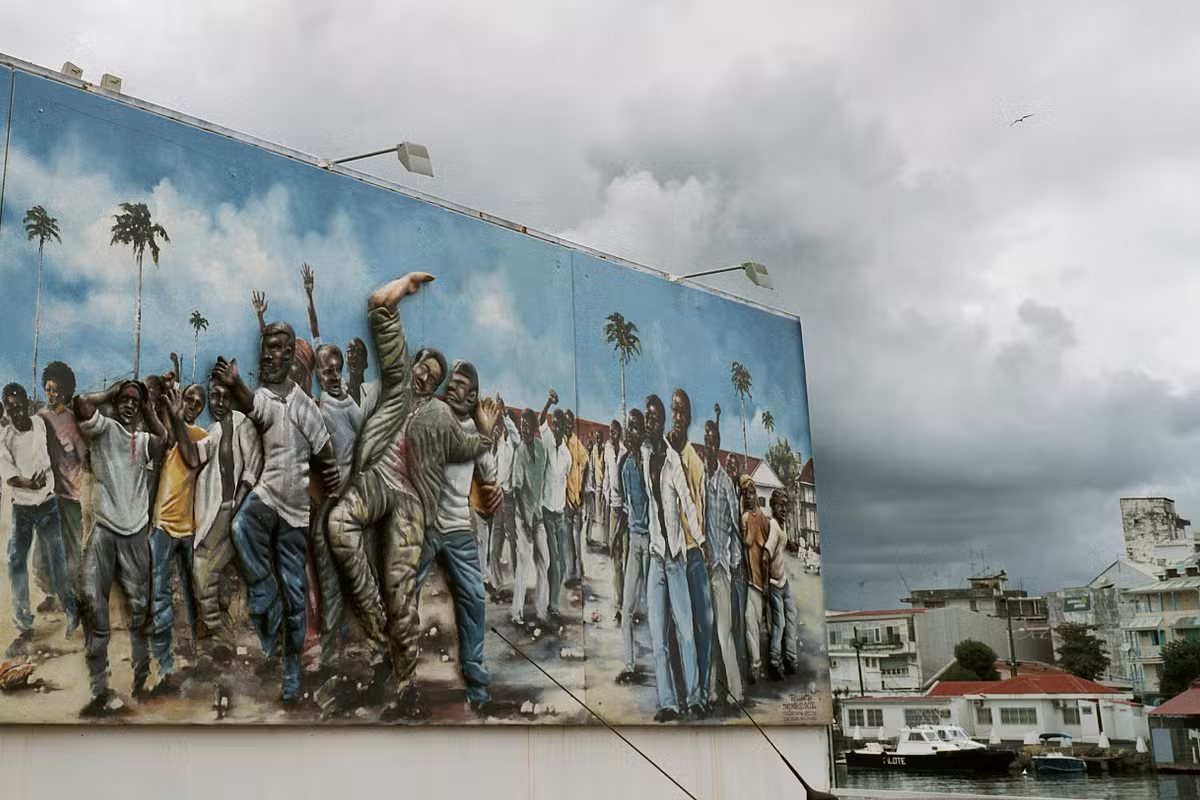In May 1967 (Mé 67), Guadeloupe erupted in a blaze of social and racial anger. Three days of fire, blood, and silence—still denied by the French State.
Mé 67, a past that still burns
Under the heavy sun of Pointe-à-Pitre, the asphalt still echoes, in places, with muffled screams. Here, the people marched not to dance but to cry out for food, dignity, and equality. And the ground, red with rage, has forgotten nothing. It holds in its veins the unspoken names, the lives cut short, the unkept promises of a Republic that dresses like a mother but strikes like a master. Guadeloupe, beautiful and wounded, caught fire in May 1967; and France looked away.
That month, events took the form of a popular uprising, sparked by a public racist insult and fueled by decades of silent domination. A seemingly spontaneous protest, but one deeply rooted in a history of unequal relations, post-colonial violence, and endemic poverty disguised as “development.”
But instead of dialogue, the response was gunfire. The authorities killed, concealed, and denied. The figures fluctuate, the testimonies tremble, the archives vanish. Even today, the memory of this massacre remains fragile, like a sentence interrupted.
How did the May 1967 riots embody an uprising against racial and colonial injustice—and why does their brutal repression remain so absent from France’s national narrative? To understand this tragedy, we must return to the origins of a long-smoldering social fire, recount its bloody hours, and trace the enduring threads of its legacy—the ones the State tried to sever, but that popular memory keeps weaving.
I. Seeds of insurrection: Land of anger, island of silence
A. Colonial legacy and social divides
Guadeloupe, dazzlingly beautiful, bears on its back the scars of a colonial past that the present refuses to bury. Here, the békés (descendants of former white masters, land-rich and power-clad) live in comfort, untouched by the winds of hardship that batter the island’s Black majority. The cane fields, once lined up under the lash, still sway under the weight of a frozen economic order. It’s no longer slavery, they say, but the social order still looks a lot like it.
The French State, self-declared protector of liberties, maintains here a system where skin color weighs like an unpayable debt. In mainland France, laws are said to be equal for all; here, equality disappears in the gaps between geography and history. Education, housing, leadership roles—everything reflects unequal distribution, where one learns early to “stay in their place.” And in this invisible structure, contempt isn’t the exception—it’s the unspoken rule, the air people breathe.
B. International and regional context
But in the 1960s, the Caribbean palms tremble with a new wind. Chains fall in Kingston and Georgetown, flags change hands and colors. Neighboring peoples claim sovereignty; independence becomes a contagious idea, a quiet fire spreading from mouth to mouth, from pirate radio to union meetings.
In Paris, this wind is unsettling. The shadow of Cuba—revolutionary, Marxist, defiant—hovers not far from Guadeloupe. And in the wary eyes of French authorities, anything that smells like protest gets filed under “Red Threat.” Guadeloupe isn’t just an island—it’s a strategic stronghold, a pawn in the Cold War geopolitical chessboard. Losing it is out of the question. And to keep it? Surveillance, intimidation, force—whatever it takes.
C. The Racist Spark
On March 20, 1967, in the quiet streets of Basse-Terre, a white shop owner sets his dog on an elderly Black shoemaker—disabled in body but upright in spirit. No one around protests. Then Vladimir Snarsky, the shopkeeper, throws a phrase like a stone: “Say hello to the nigger!” It isn’t an outburst—it’s a summary. In a few words, the brutality of a system that never really died is laid bare. The humiliation isn’t just physical—it’s ritualized, coded, public.
This scene—almost ordinary in colonial life—this time ignites fury. The people, tired of lowering their eyes, choose to look directly at those trampling them. The overturned shoemaker’s stall becomes a symbol of all buried injustices. The dog, weapon of unrepentant racism, embodies persistent dehumanization. That day, the island stops being silent. That day, Guadeloupe begins to scream.
II. Three days of fire: The state shoots, the people bleed
A. The rise of tension
May 1967 begins with an old weariness—but it soon explodes. Construction workers (those who bear the island’s foundations on their backs) demand a 2.5% raise. Just two and a half percent—to offset years of invisibility, miserable wages, lives worn out too early. This demand isn’t a luxury—it’s a last gasp before suffocation.
In front of Pointe-à-Pitre’s Chamber of Commerce, hundreds wait under the sun. The air is thick, eyes tense. Then a sentence cuts the silence like a machete: “When the niggers get hungry, they’ll go back to work.” These words—attributed to Georges Brizzard, a white business owner and local elite—fall like a slap on an already kneeling crowd. It’s more than an insult: it’s a revelation. This is what the establishment thinks. This is what the State protects.
B. Bloody clashes
On May 26, 27, and 28, the island tips into turmoil. Talks break down, tempers flare, the riot police charge. Tear gas, batons, rifles—weapons speak where voices are silenced. Protesters fight back with what they can: stones, conch shells, shouts of rage. But the imbalance is glaring. Blood flows quickly.
Jacques Nestor, GONG activist, falls on May 26. He is young, standing tall, dreaming of a self-governing Guadeloupe. His death marks a turning point. Anger turns to fury; fear turns to silence. In Pointe-à-Pitre’s streets, gunfire echoes. Bystanders are targeted, children injured, homes raided without warrant. Death stalks—absent from official counts but engraved in memory.
Nestor’s body, sprawled on the ground, becomes a symbol. Not of a mythic martyr, but of a man among many, struck down for daring to hope. Around him, others fall—nameless or forgotten. Their names, often misspelled or never recorded, vanish into collective terror.
C. The armed state
The arsenal deployed against its own people says it all about the Republic’s stance: it does not debate—it punishes. Riot police, mobile gendarmes, “red caps”—all armed, all authorized to shoot. Prefect Pierre Bolotte signs the orders, and Paris approves in silence. The army, an occupying force on French soil, acts as if subduing a conquered land.
In the background, the silhouettes of Pierre Billotte, Jacques Foccart, and General de Gaulle loom. They don’t fire, but they permit. They know. Guadeloupe is a strategic rock, a colonial display repainted in republican colors. No question of giving in—let alone acknowledging the rising voices.
And when the bullets stop, silence falls. But it’s not a natural silence—it’s a lid clamped over truth, a leaden cover enforced by law, bureaucracy, and media. The dead are buried hastily, numbers hidden, documents filed away. The hope? That the people forget.
III. Organized oblivion, resisting memory
A. Official erasure
Once the gunfire stopped and the smoke cleared, the State erected no monument, held no mourning. It lowered the curtains. The official death toll? Seven—a timid, almost trivial figure, compared to testimonies, heavy silences, and averted gazes in Pointe-à-Pitre’s streets. In 1985, Georges Lemoine, Secretary of State for Overseas Territories, suggested another number: 87. And historians go further—up to 200 victims.
But these figures float—without official graves, without death certificates, without justice. Why? Because the archives were sealed as “defense secrets” until 2017. Because some were destroyed, others never created. Because, in what they call the “overseas,” truth is often seen as a threat.
Families stayed silent—not from forgetfulness, but fear. In an island where everyone knows someone who works for the prefecture, where suspicion lingers, it takes courage to speak. And that courage, the State never recognized. It preferred to muzzle it.
B. Memory that fights back
But a memory, even denied, finds its paths. It passes through elders’ stories, rare books, the voices of persistent historians. Jean-Pierre Sainton, Raymond Gama, Benjamin Stora—they dug, cross-checked, resisted amnesia. Not as heroes, but as watchmen.
With every painted mural, every sung verse, every novel inspired by those dark days, a bit of light returns. The mural by Philippe Laurent, raised in Pointe-à-Pitre in 2007, is not just a tribute—it’s a monument against forgetting. The songs of Biloute or Raphaël Zachille mourn what history books still refuse to print. Fiction itself (from Gerty Dambury to Thomas Cantaloube) becomes a necessary parallel truth.
These are intimate, modest, but powerful acts of resistance. And in each one, we hear the same haunting question: “Why don’t they want us to remember?”
C. History still on trial
That’s the crux of the silence. Why does France, so quick to celebrate the Resistance, refuse to recognize its late colonial violence? Why is this massacre—committed by French forces against French citizens—not taught in schools? Why has there never been a truth and reconciliation commission?
The shadow of May 1967 still hangs over contemporary Guadeloupe. It doesn’t explain everything—but it infects everything: the mistrust toward the State, the strength of movements like LKP, the recurring calls for political recognition, even autonomy. When a people sees its dead erased, it learns to distrust the democracy it’s sold.
And yet, despite denial, memory lives. It survives in words, in sounds, in flesh. Like the sea that kisses the island’s shores each morning, it returns endlessly—untamed.
The sea knows the truth

The sea of Guadeloupe, vast and silent, never needed archives. It knows. It saw the bodies fall, heard the cries vanish into narrow alleys, washed the blood of May 1967 without ever betraying its memory. Every wave that strikes the rocks seems to whisper forgotten names, truths the State tries to bury but that popular memory refuses to abandon.
This massacre is not a footnote in history; it is an open wound, a pain shared by a whole community whose dead were never mourned aloud. It is time—long past time—to acknowledge what happened. To look squarely at those days when the Republic fired on its own children. To stop writing history in the conditional tense.
Because memory is not a relic preserved in the formaldehyde of forgetfulness. It is a weapon—against lies, against erasure. It is a prayer—for the tombless dead, for the living who still fight. It is a legacy—a truth to be passed down, so the children know, so the oppressors don’t erase the trail.
And maybe, one day, the sea will speak.
Maybe, one day, France will listen.
Sources
- Sainton, Jean-Pierre. Mé 67: Mémoire d’un événement. Guadeloupe: Société guadeloupéenne d’édition et de diffusion, 1985.
- Gama, Raymond. Mé 67: Mémoire d’un événement. Port-Louis: Lespwisavann, 2011.
- Francis, Gladys M. Dialogism, Exoticism, and Chaos in the Caribbean Context. Cambridge Scholars Publishing, 2018.
Table of Contents
- Mé 67, a Past That Still Burns
I. Seeds of Insurrection: Land of Anger, Island of Silence
A. Colonial Legacy and Social Divides
B. International and Regional Context
C. The Racist Spark
II. Three Days of Fire: The State Shoots, the People Bleed
A. The Rise of Tension
B. Bloody Clashes
C. The Armed State
III. Organized Oblivion, Resisting Memory
A. Official Erasure
B. Memory That Fights Back
C. History Still on Trial - The Sea Knows the Truth
- Sources
